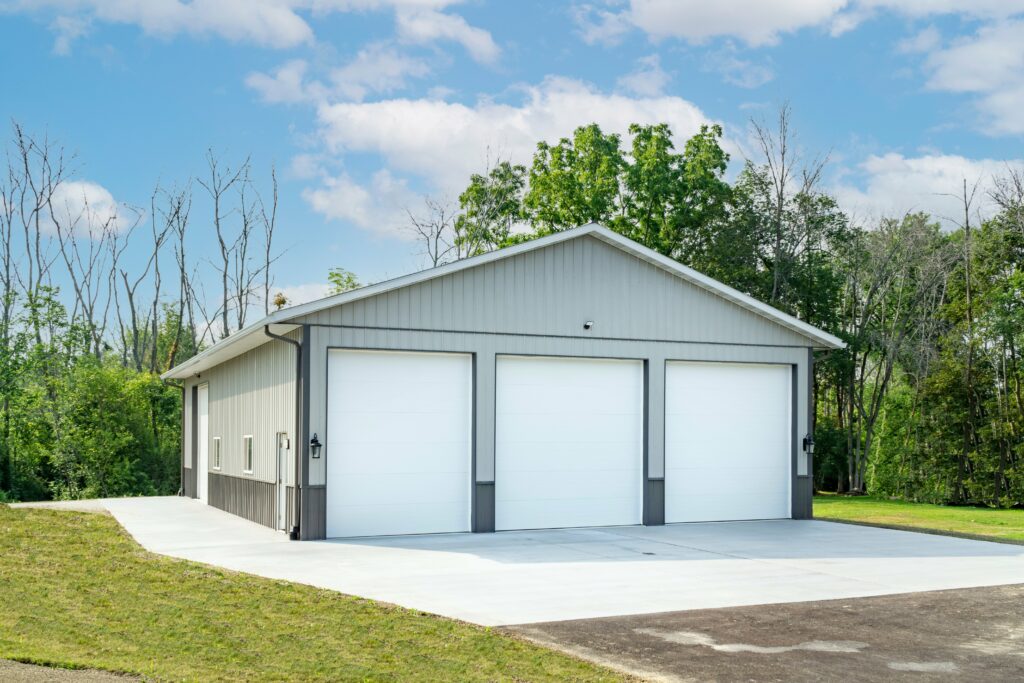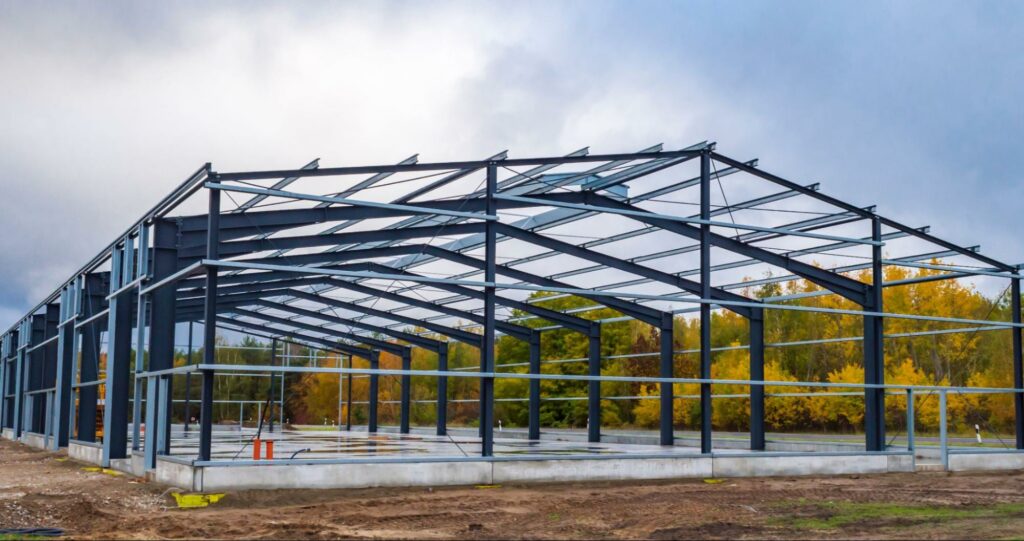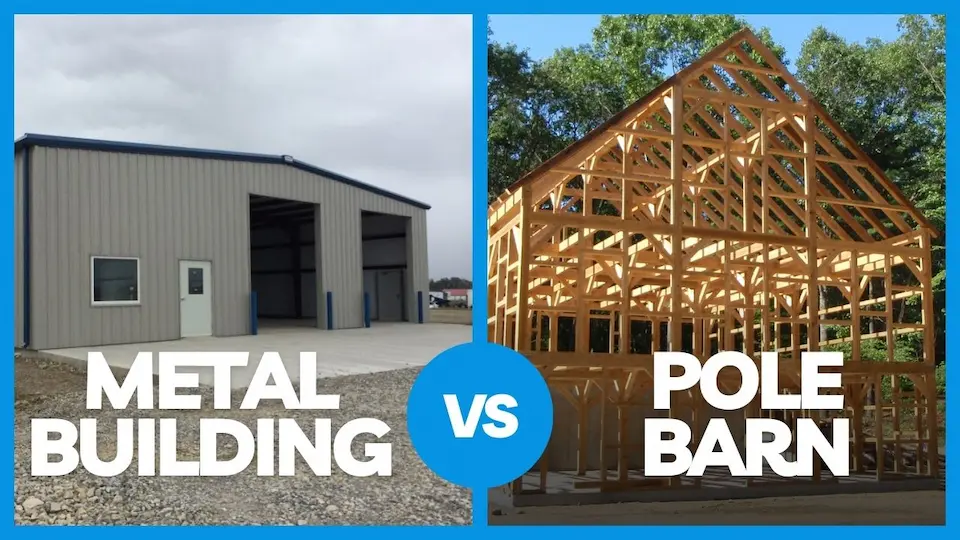Debating between a pole barn and a metal building? Each has its perks, but your best pick depends on your needs and goals.
Whether it’s for a workshop, garage, or livestock shelter, this guide breaks down the pros, cons, and key differences to help you choose the right fit for your next build.
What is better, a pole barn or metal building?
It depends on your needs! A pole barn is great for low-cost, easy-to-build structures, while a metal building offers better durability, insulation, and protection against harsh weather.
Key Takeaways
- Pole barns are often more affordable, quicker to construct, and versatile for various uses.
- Metal buildings provide durability, low maintenance, and better resistance to the elements.
- Your choice depends on factors like budget, intended use, and long-term durability.
What Is a Pole Barn?

A pole barn is a type of building constructed with wooden posts (poles) buried in the ground or anchored to a concrete foundation. The frame is built around these poles, with horizontal girts and trusses, and the exterior is typically made of wood, metal, or other materials.
Pole barns are commonly used for agricultural purposes, but they can also serve as workshops, storage sheds, or even homes in some cases.
Advantages of Pole Barns
Cost-Effective: Pole barns are generally cheaper to build than metal buildings, making them an attractive option for those on a budget.
Quick Construction: Since the poles act as the main structural support, pole barns are faster to construct compared to metal buildings, which require a more intricate framework.
Versatile Design: Pole barns can be finished in different ways, from wood to metal or even a mix of both. Many owners look for the best metal pole barn siding options to get durability without sacrificing style, giving them more flexibility in the final look.
Better for Rural Areas: Pole barns are ideal for rural settings where the ground may not be stable enough for traditional foundations, making them a great option for agricultural properties.
Disadvantages of Pole Barns
Less Durability: While pole barns are sturdy, they are more susceptible to weather damage, particularly from heavy winds and rain. The wooden posts can also deteriorate over time if not treated properly.
Maintenance Requirements: Pole barns typically require more maintenance than metal buildings, especially when it comes to checking the wooden poles for rot, pests, and other wear.
Limited Insulation: Insulating a pole barn can be more challenging, especially if the building is not initially designed for it. This may limit its functionality in colder climates.
What Is a Metal Building?

A metal building, also known as a steel building, is a structure made primarily of steel or other metals for the frame and exterior walls.
Metal buildings are a popular choice for industrial, commercial, and residential projects thanks to their durability and low maintenance needs. Read more on 30×50 pole barn designs to see how these structures can be customized for various applications.
They are often chosen for their strength and longevity, as well as their ability to withstand extreme weather conditions.
Advantages of Metal Buildings
Durability: Metal buildings are built to last. They are resistant to fire, termites, rot, and other common problems associated with wood structures. Metal buildings can withstand harsh weather conditions, including high winds, heavy rain, and even snow.
Low Maintenance: Unlike wood structures, metal buildings require very little maintenance. They don’t need to be painted regularly, and their frames are less likely to warp, crack, or rot.
Energy Efficiency: Metal buildings can often be more energy-efficient than pole barns, especially when properly insulated. If you’re wondering can you paint metal pole barn panels, the answer is yes — and those painted steel panels not only improve appearance but can also help reflect heat, keeping the structure cooler in summer and warmer in winter.
Long-Term Value: Metal buildings are built for the long haul. While the initial investment may be higher, their longevity and low maintenance requirements make them a solid investment in the long run.
Disadvantages of Metal Buildings
Higher Initial Cost: Metal buildings are typically more expensive to build than pole barns, both in terms of materials and labour. However, the long-term savings in maintenance and repairs can offset this initial cost.
Slower Construction: Metal buildings require a more detailed and precise construction process, which can make the building process take longer compared to pole barns.
Limited Design Flexibility: While metal buildings offer modern designs, they can lack the aesthetic versatility of pole barns. If you’re looking for a more rustic or traditional look, a metal building may not be the ideal choice.
Key Differences Between Pole Barns and Metal Buildings
While both pole barns and metal buildings offer unique benefits, understanding their key differences is crucial when making a decision.
Here’s a breakdown of the primary factors to consider:
Cost
Pole Barns: Generally, it’s more affordable to build thanks to lower material costs and quicker timelines. Choosing pole barn construction with metal trusses makes the process even faster, though it’s worth noting that maintenance expenses can add up over time.
Metal Buildings: Tend to have a higher upfront cost due to the materials and detailed construction process. But with less maintenance required, the long-term costs are lower.
Construction Time
Pole Barns: Faster to build, which makes them a good choice for projects that need to be completed quickly.
Metal Buildings: Typically take longer to construct due to the need for precise assembly and the use of heavy-duty materials.
Frequently Asked Questions
1. Can you insulate a pole barn as well as a metal building?
Yes. Both can be insulated well, though steel may need special vapor barriers to prevent condensation in cold climates.
2. Do pole barns need a concrete floor?
Not always—a slab is optional. Many builders go with gravel or dirt floors to cut costs, but when choosing between steel building or pole barn, it’s worth weighing long-term durability and maintenance too.
3. Which building adds more value to a property?
Metal buildings often increase property value more due to longevity and lower maintenance, but a well-finished pole barn can also offer strong resale appeal.
Conclusion
Choosing between a pole barn and a metal building ultimately depends on your specific needs and preferences. If you’re looking for a cost-effective solution with quicker construction and a more rustic look, a pole barn may be the right choice for you.
On the other hand, if you prioritize durability, low maintenance, and energy efficiency, a metal building is likely the better investment.
No matter which option you choose, make sure to consider the long-term costs, the climate in your area, and how you plan to use the building.
Both pole barns and metal buildings offer unique advantages, and understanding these differences will help you make the best decision for your project.

